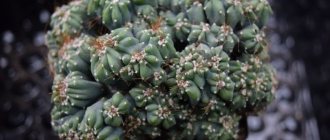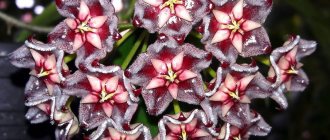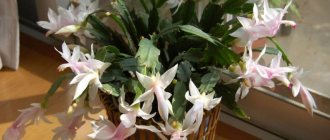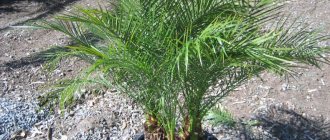general description
Cacti are a favorite plant of many gardeners, but not many know what the hairy cactus is called and that it even exists. Such a plant is unpretentious in care; it can easily exist in the home of a person who often forgets about watering.
Fluffy cacti
Thanks to the white cloud of hairs, the plant is protected from the scorching rays of sunlight and various pests. The appearance of the succulent makes it stand out from its nondescript counterparts.
Interesting information! One of the first to study this type of succulents was Esposto Nicholas, after whom the fluffy cactus was named.
What does a fluffy cactus look like?
Often Espostoa can be confused with Cephalocereus. This is also a small genus of cacti, including several species of plants, but they branch at the roots and have long and thick light spines, which are much tougher than those of their furry counterpart.
The fluffy cactus has a columnar structure, sometimes with branching stems, which in appearance may resemble a candelabra. The trunk and shoots have a green or gray tint, some types are darker. The plant is completely covered with long white hairs, which grow most abundantly at the top.
Espostoa
Radial spines have a light yellow or red color, usually their length does not exceed 1 cm. The central spines are much longer (can reach 4 cm), differ in color depending on the species.
Espostoa: types of cactus with description, care and reproduction
Espostoa is an unusual cactus with a shaggy cover, which gardeners often affectionately call “fluffy” because of this feature. It can serve as an exotic decorative interior detail that is easy to care for.
It includes about 16 varieties. All of these species look roughly the same: spiny plants with a fluffy cover. At the same time, the hairs are soft and hide the cactus from scorching rays.
It grows naturally in the mountains of Peru and Ecuador.
What is a cactus
The cactus received its unusual name from the name of a Peruvian botanist living in Lima at the beginning of the 20th century. It differs from others by being covered in white hairs. Depending on the type of plant, their cover and density differs. In common parlance it is called “cotton cocoon”.
In the mountains of Peru and Ecuador, espostoa can reach five meters, and only the top of the cactus is covered with hairs. They can bloom with flowers that look like bells. The flowers reach five centimeters in diameter and open only at night. After flowering, black fruits covered with fluff appear in their place.
Only miniature cacti that do not grow more than 70 centimeters are domesticated. They can be grown both indoors and in greenhouses. These plants can differ in their size, downy cover and stem shades. For example, some varieties have a bluish waxy coating on the trunk.
Espostoa black columnar
The cactus stems are emerald to black in color and grow up to two meters. All hairs are concentrated at the top. There are many light yellowish spines on the stem. Plant flowers: white. In its natural environment, the cactus grows in the mountains.
Espostoa Ritter
This is a beautiful decorative variety, which is bred from woolly espostoia. The cactus stem resembles a tree and can grow up to four meters. Sometimes it has lateral layers.
There are white hairs up to 30 mm on the stem. long and yellow spines, reminiscent of a needle in shape. Espostoia Ritter's flowers are white and up to eight centimeters long.
Popular: Proper care of cleistocactus at home
Cactus care
The plant is considered unpretentious, but if you care for it incorrectly, it slows down its growth and loses its decorative properties.
Light
Since the cactus grows in high solar activity, it needs a lot of light. The plant does not overheat, thanks to the coating with thin fibers. Therefore, it can be placed on a south window, it will not be scorched by the caustic sun.
The more fluff on the stem, the more sun and light the cactus needs. But when transitioning from winter to summer, on the contrary, you should gradually accustom the cactus to the sun's rays. In winter it is illuminated with an artificial lamp.
Temperature
The plant loves warmth, so in summer the temperature in the room can be up to 30 degrees. This will not harm the plant.
In winter, it is transferred to a period of rest, reducing the temperature in the rooms to 10–15 degrees. To do this, the pot with the plant is placed in a cool room. This cactus does not tolerate sudden changes in temperature, so sudden temperature fluctuations should not be allowed. In summer, it is recommended to take the espostoa to a loggia or balcony so that the plant receives fresh air.
Watering mode, air humidity
The plant should not be watered frequently because it is a cactus accustomed to arid climates.
Even when the cactus is actively growing, water it no more than once a week, after the soil has completely dried. In winter, esposta is watered even less frequently, for example, once every 30 days. The cactus does not tolerate flooding.
The bottom of the stem and its roots can rot if there is an abundance of water. To help water penetrate better into the pot, light soil is poured.
The plant does not need too humid air or spraying. When moisture gets on the fluff and needles, they quickly become covered with an unsightly coating, and the cactus loses its decorative effect. It is necessary to water only with warm water, which is pre-settled. The water temperature should be no more than 25 degrees.
It is important that the growing container has a drainage layer, because water should not be retained in the soil. If the plant is young and has not yet formed, this may cause the cactus to die.
How to feed a cactus
It is possible to feed espostoa, but this is done in small doses, because the plants do not require fertilizer. The procedure is carried out during the period of active growth (from May to September). At the same time, the plant is fertilized at the rate of a quarter of the recommended concentration. Feeding is done once every 3-4 weeks.
Popular: Beautiful flowering of epiphyllum after planting in a pot
In this case, the root system must be moistened with water so as not to damage the fertilizer with a caustic composition. You can use mineral fertilizers intended for succulents. It is possible to use universal or organic fertilizers.
How to behave after buying a cactus
Its health depends on the condition in which the espostoa was purchased. First of all, you need to inspect the pot for the presence of parasites. To do this, take the container in your hands and carefully examine the hairs, soil and the plant itself.
https://www.youtube.com/watch?v=45p1BzTy2bM
They should not be brittle, too loose or sparse. The barrel must be free of mechanical damage. If it is scratched or too soft, then it is easier to refuse to buy a cactus and buy yourself a healthy one. In the first two weeks, the plant should not be touched again, much less replanted. During this period, the plant is still adapting.
Cactus reproduction process
The plant can propagate by seeds, cuttings or lateral layering. When planting seeds, planting material is sown in a bowl of soil. The soil is prepared independently from garden soil and sand. After sowing, it is necessary to cover the container with film or a sheet of glass. The container with seedlings is placed in a bright, warm place with a temperature of 20 to 25 degrees.
Propagation using cuttings occurs in this way: they are cut from the top of the plant, slightly dried, and then planted in a substrate with the addition of peat. If it is necessary to propagate a cactus by layering, then they do this by separating the shoots from the old mother plant and simply plant them in the ground.
Difficulties in growing the plant
In cases where brown or yellow spots appear on the trunk, but it retains its hardness. This means trying it out.
The grower should worry more when the stem of the espostoa becomes wet, slippery and soft. Such symptoms indicate the beginning of rotting. Rotting begins with excessive watering.
The process develops from the root system and the bottom of the trunk, gradually rising to the top.
To save the plant, you need to cut off the rotten ones, powder it and lightly dry it in the open air. Before planting it in the ground again, additional treatment with Kornevin is necessary.
If only the top remains intact, it is not buried, but simply planted on the soil and wait until it begins to take root. To prevent this from happening again, do not fill the espostoa with water.
Popular: Variety of varieties and features of caring for lobivia cactus
If spots appear on the plant
The presence of spotting means that the grower changed the conditions for caring for the plant or put it in the shade.
In this case, brown or gray spots develop, which occur due to the plant being infected by pests or pathologies. Pests are not always visible due to the fluff.
You should not spray the plant with a spray bottle, because the hairs stick together and the plant loses its beautiful decorative appearance.
To prevent the espostoa from becoming infected with pests or infectious diseases, it is necessary to process the roots in a timely manner. To do this, once every few months it is watered with phytosporin and examined from all sides.
Loading…
Source: https://GardenGround.ru/kaktusovye/espostoa/
Main varieties
Queen of the night cactus: main varieties and care options
According to different classifications, espostoa has from 10 to 16 varieties. Miniature species of this cactus are usually grown at home, but large plants can also be found in rare collections. Espostoa cactus differs not only in size, but also in stem color and fluffiness.
Espostoa woolly
Espostoa woolly (lanata) is the most popular variety for breeding at home.
This plant has the appearance of a column, from which up to 30 lateral ribs extend. Under natural conditions, the size of a hairy cactus can reach 5 m, but the indoor plant usually does not grow above 1 m.
Additional shoots appear on an adult plant, due to which the cactus begins to branch far from the base. A larger number of radial needles, which have a yellowish color, break through the wool. The spines can reach 5 cm in length.
Young Espostoa Lanata
Espostoa is amazing
This type of fluffy cactus has an almost white color - it can range from light green to grayish. The diameter of the stem can be 9 cm and the length 0.5 m. In wild conditions, these data also differ, but indoor conditions do not allow the plant to grow much.
The top of the plant is covered with a large number of long white hairs that stick out in different directions. Large areoles with needle-like spines in the center and bristly radial spines are whitish-red in color.
The longer spines are located in the lower part of the plant, which is what distinguishes Espostoa amazing from other species.
Other varieties
Espostoa nana has increased fluffiness, which is combined with the small size of the plant itself. At home, the succulent does not bloom, but some people decide to grow it for the sake of its appearance, which resembles a fur roll.
The shaggy Ritteri cactus is quite long (up to 4 m) with a significant number of dark-colored branches. One column has up to 20 small ribs, which are separated by transverse grooves. The cactus is distinguished by the presence of one central spine, which has a dark color, which can reach 2 cm. The remaining needles have a yellowish or brownish tint, while one Ritteri usually has about 25 spines.
Black-columnar espostoa is considered a rather exotic species. The cactus got its name from its long trunk, reminiscent of a column. The color of the trunk can range from dark green to black. In nature, the height of the plant reaches 2 m.
Black-columnar espostoa
Interesting information! The cactus is almost completely covered with long white hairs that protect it from pests. The plant has 24 ribs, which are completely covered with hairs, but among them you can see brown spines.
Espostoa senilis (senile) is native to Peru. A fairly tall, columnar plant, the white straight spines of which resemble hairs. Radial spines are densely located on the stem, and central ones appear only on mature plants. Flowering occurs only under natural conditions.
Succulents - photos in the interior and names of indoor cacti
Cactus is a plant that has already become a favorite of many gardeners. Its popularity is ensured by its variety of forms, ease of care and colorful flowers, which do not appear so often.
A special place in this family is occupied by fluffy cacti, which are sometimes also called hairy cacti.
In the article we will tell you what the distinctive features of fluffy cacti are and how to care for them, what types there are and what they are called, and we will also show photos of these beautiful, unpretentious plants that can be purchased both for the home and for the workplace.
Fluffy cacti are no different in shape from other types of common house cacti. The main difference is that on the surface of the plant there are thin white hairs that completely cover it. Because of this characteristic hair color, plants of this type even acquired the nickname “Peruvian old man.”
- Fluffy cacti tolerate drought well. They need to be watered as the earthen ball dries out, and from October to April, watering can be reduced to once a month while the plant is in its dormant period.
- The main condition for growing succulents, including fluffy cacti, is well-drained, slightly acidic soil that will not retain moisture. You can add expanded clay or even crushed brick to the pot, which will allow air to flow to the roots of the plant.
- Despite their love of drought, cacti sometimes need air humidification. However, you should absolutely not bathe fluffy cacti in the shower. The hairs covering their surface perform a protective function.
And if they get wet, they will stop being so fluffy and will become crumpled. This will disrupt the natural protective barrier, and the plant will become susceptible to environmental influences. It is better to simply moisten the air around the plant with fine water dust, which will not settle on the hairs and form a limescale deposit on them.
- Fluffy cacti love sunlight. The more hairs on the surface of a succulent, the more light it needs. At the same time, he is not at all afraid of direct sunlight. The main thing is not to expose it sharply to a brightly lit place after winter, but to let it get used to it a little.
- Drought-resistant;
- Cuticle. The waxy coating protects from the bright sun;
- If the drought is prolonged, then some of the stems die off and moisture circulation is resumed;
- Elastic leaves and ribs located on the stem will prevent it from cracking if too much water has accumulated.
Fluffy cacti generally do not bloom at home. Most likely, the lack of flowering is due to the fact that at home on the windowsill they do not reach the same size as in their natural habitat. Only specialists in equipped greenhouses were able to create conditions comfortable for flowering.
We will look at succulents (photos and names) and everything you need to know about these incredible, wonderful plants in this article with a detailed description. You will also learn the main types that decorate homes and offices. Habitat: Africa, India, Madagascar.
READ MORE: Red anthurium 25 photos on how to care for an indoor flower at home Names of popular varieties of family happiness
Despite the huge number of subspecies, there are some common features:
There are an incredible variety of them, let’s highlight the most popular representatives that you probably could have seen somewhere. We will make a review with recommendations for care at home.
Translated from Arabic it means “bitter”, there are more than 40 subspecies. It is popular in cosmetology because it contains many vitamins.
Gasteria
The name comes from Lat. the words “gasltron” and is translated as a pot-bellied jug. With proper care, it can bloom.
sedum
The leaves are small but dense. It can easily withstand temperature changes and is suitable for hot regions. Regular watering is required only in summer, and it blooms quite rarely.
Crassula
It is unpretentious in its operation; even a person who is not well versed in all the intricacies of spraying and transplanting can cope with it. The plant blooms mainly in spring, but only in natural conditions; for the home this is very rare.
Conophytum
It is advisable to place it in a dry, ventilated room and direct diffused light at it; it does not like direct light. Water exclusively through a tray, avoiding moisture getting on the leaves. The flowering is bright, beautiful, and coincides with the period of active growth.
Aeonium
It is part of the Crassulaceae family and includes 40 varieties of perennials.
Always bet on the bright side.
Completely unpretentious in care, accustomed to drought. Has proven itself in the textile industry. Due to its strong fibers, it is used in coat and furniture fabrics.
Ragwort
Suitable for growing in the garden and at home, also used for decorating bouquets.
Requires a lot of light, it needs direct rays.
In summer, watering should be constant, once every 2-3 days; in winter, watering should be kept to a minimum. Use fertilizers for feeding (March-August). Used as wall decor.
Spurge
You need to place it in direct light, you can even turn on additional lighting. When watering, observe moderation.
Haworthia
Avoid oversaturation with water. Wait until the soil is completely dry and water. Feeding will only be needed in spring and summer. A special solution for cacti is used.
Apthenia
It is necessary to feed with fertilizers from spring to autumn. It blooms if it does not lack sunlight.
Pachypodium
Spectacular, suitable for a winter garden or to decorate a store window.
It is important to remember that for all, feeding should be exclusively root feeding; they will not tolerate spraying.
- Fertilizer should be applied mainly during the growth period (March), increase during flowering, reduce in the fall and completely stop in the winter.
- Despite all the diversity, there are still 3 types:
- Cacti. Protected from the sun by thorns, they protect from being eaten by animals and help to collect more moisture.
- Leafy. Used to create interior compositions.
- With caudex. A large trunk that retains liquid and can survive dry periods.
Useful tips
Complete additional nutrition by September. Nutrients are only absorbed when the plant is in good, disease-free condition.
The period of rest is not only in winter, but also in sultry heat. Dose wisely. Oversaturation threatens with irreversible consequences: rot in the soil, an increase in parasites.
Drugs
- Good power (B1, PP).
- Agricola
- Bona forte
- Etisso
Supports immunity, improves growth.
Folk remedies
- Egg shells (contain a lot of calcium) are cleaned, crushed and added to the ground.
- Ash. Dilute with water in a ratio of 1 to 3 and leave for several days, adding to the soil once every 2 weeks.
In general, they easily adapt to dry rooms with insufficient light. They do not require frequent watering, withstand sudden changes in temperature well, and are unattractive to pests. They are for those who do not like to pay much attention to care activities, but rather like to get the finished result.
Today they are used in interiors. There is even a direction for vertical gardening, for which species with long hanging shoots are usually common. They have a beautiful shape:
- rhipsalis
- epiphyllums
- Schlumbergia
- aromiscus
- Anacampseros
- Brighamy
- Guernia
- lampranthus
- pachyphytum
- faucaria
- phocaea
- Cerochlamys.
Special: trachyandra tortilis, sedum morgana, umbellifera, dolphinum, echeveria agave, stapelia, amrometella, argigoderma (living stone), aichrizon, bryophyllum, graptopetalum.
- caralluma,
- hoodia,
- stapelianthus,
- tromotriche,
- desmidorchis,
- pyaranthus,
- edittrack,
- orbeya,
- Tavaresia.
These are the subspecies that are suitable for the unique decor of any room.
Landscape designers note the interesting texture, bright palette of shades, as well as convenient plasticity in creating unusual compositions. For a desktop or small kitchen there are also varieties that can be designed in the form of a small vegetable garden or garden. Looks good in glasses and aquariums.
Photos of succulents
Unpretentious and easy to care for, succulents are used to decorate garden plots, alpine slides and decorate window sills. Accustomed to temperature changes, easily tolerating lack of watering, bright sunlight or prolonged partial shade - ideal for a beginner or not too attentive gardener.
AgaveAgave americana and Agave Queen Victoria are varieties of this plant. Hard, dense leaves of green, dark green or green with yellowish stripes. The edge of the leaf is sharp.
The leaves grow in a circle from the central leaf. The plant requires a temperature of 8 to 21 degrees, watering once a month and no direct light. Agave americana rarely blooms; Queen Victoria is not a flowering plant.
Adenium has a tree-like trunk and many small leaves. Loves warmth and moisture. Spray the leaves of the plant once a day, water once every three to four days. Comfortable temperature not lower than 12 degrees. Blooms infrequently, producing many pink small flowers.
Adromiscus A plant with thick, downy, spotted leaves, loves watering and light partial shade.
Adromiscus Photos
Aloe Thin, sharp, dark green leaves grow in a circle. It does not require special care. The plant is not tall and rarely blooms. There are several varieties of aloe: aloe tree, squat, folded fan, variegated, spinous. A variety such as aloe squat has healing properties.
Photo of aloe
Anacampseros Ampelous succulent. Purple shoots with small, fleshy green leaves. Loves moisture and sunny color. It weaves well. Blooms profusely with pink flowers of regular shape.
AptheniaA low, sometimes climbing plant with fleshy, rounded leaves and small flowers. Requires abundant watering and good lighting. The temperature should be maintained at a level not lower than 18-20 degrees.
Argyroderma A tiny perennial plant consisting of two fleshy gray-green leaves that face each other and form a cup-like shape. Blooms once every few years. The flower is comparable in size to a plant and has pink or white petals. Water as the soil dries out in summer and once a month in winter. Fertilize in summer. Avoid direct sunlight.
READ MORE: How to connect a speaker to your phone via Bluetooth How to turn it on on iPhone and Android How to use a Bluetooth speaker via a tablet
Flower care rules
With proper care, there will be no problems with the succulent. It is required to choose the plant especially carefully so that it does not have diseases or damage from pests. The trunk should not have soft or loose areas. If the cactus has sparse and fragile hairs, then it is recommended to pay attention to another plant.
Temperature
How often to water a cactus: quantity and options at home
Espostoa is a fairly heat-loving plant, so it feels good only in warm climates. It is recommended to keep the fluffy cactus at a temperature of 17-24 degrees; in the summer, the upper threshold may exceed 30 degrees.
Important! In winter, the plant is in a dormant period, so it is recommended to keep it in a cooler room, where the temperature drops at least 8 degrees. A succulent can get sick if the temperature changes suddenly.
Espostoa in a pot
Sufficient lighting must also be provided. The cactus can be placed on south-facing windowsills, since the hair protects the trunk from thermal burns. But at noon, it is recommended to either shade the plant or open a window so that the supply and exhaust ventilation cools the flower a little. In the cold season, it is necessary to provide the plant with additional lighting.
Humidity
Air humidity is not an important criterion for the growth of shaggy cactus. It is recommended to avoid spraying with water, as this will cause plaque to appear on the hairs, making the plant look untidy.
Watering
The plant does not require frequent watering, since it comes from fairly dry places.
During the active growth phase, it is recommended to water no more than once a week or 10 days. In winter, when the plant is dormant, it is worth reducing water treatments to once a month, since the cactus reacts extremely negatively to large amounts of water and begins to rot.
Important! For irrigation, you must use soft water at room temperature, which must first be well settled.
The soil
You need to make your own soil.
It must be loose enough to allow water to pass through well, otherwise its stagnation will lead to rotting of the lower part of the cactus trunk. You can use a ready-made store-bought substrate, but you need to add a small amount of perlite or vermiculite to it.
The substrate itself is made from peat (2 parts), coarse sand (2 parts), leaf soil (1 part).
There must be a drainage layer at the bottom of the pot.
Top dressing
Fertilizing is required, since in an individual pot, humus quickly becomes salty and becomes poor in nutrients. To avoid burning the roots of the plant, it is recommended to water the soil first.
As a fertilizer, it is worth using special complexes for feeding succulents and cacti.
Fertilizer for cacti
Problems growing?
Espostoa cactus, like all “thorns”, is not difficult to care for.
However, sometimes the furry can be mopey! What are the symptoms? e. woolly
- If Espostoa has dark spots at the base...
Adult cacti are characterized by suberization of the base of the trunk, which is expressed in a change in color - yellowing, darkening. But at the same time the trunk remains solid! If the trunk becomes soft and damp at the base, this is an obvious sign of rotting of the cactus. This happens when the watering regime is violated, to which espostoa are very sensitive. They usually start to rot from the bottom up, so you can try to save the top.
Cut off the rotten part without leaving any residue, powder the cut with ash or charcoal, lightly dry it in air and dust it with Kornevin powder before planting. Place the treated top on the surface of the soil (do not bury it) and wait for roots to appear. To avoid relapse, do not water the cactus until noticeable roots appear.
- If espostoa has plaque on the areolas, or spots...
Spotting is a sign of errors in care; perhaps there were sudden changes in maintenance, or the espostoa was deprived of sunlight. However, pronounced brown or gray spots may be the result of disease or pest activity. At the same time, the latter are not easy to see because of their thick hair.
It is not recommended to spray this type of cactus: any liquids can leave sediment, the hairs will stick together and the cactus will lose its decorative appearance. In this regard, for the treatment and prevention of diseases and pests, it is worth carrying out root treatment. It is recommended to water the succulent once a season with a solution of phytosporin and regularly carefully inspect it in order to notice any changes in time.
This cactus should certainly be present in the collection of every gardener. After all, he is very sweet and undemanding! Now you can tame the fluffy Espostoa cactus.
Support our site, share the link on social networks. Thank you!
Caring for a shaggy cactus is simple, like most representatives of this species, but Espostoa also has some nuances that you need to know about in order to grow a healthy plant:
- A yellowish coating may periodically appear on the needles. Most often this happens if the plant has suffered stress. The dying areas of the fluffy “crown” simply need to be trimmed, after which the conditions of detention are brought into compliance with the rules.
- At home, this cactus often suffers from excess moisture. If the needles at the base of the trunk begin to turn yellow or darken, but the skin itself is still green, this means that the process of rotting has already begun. In this case, you need to minimize watering and remove infected spines.
- Espostoa is difficult to propagate at home due to its structural features, therefore, without proper experience, it is better for the gardener not to undertake this process. The plant can easily be destroyed by improper formation of air layering.
Espostoa is a cactus from a fairy tale, fluffy and absolutely harmless, which attracts attention even without bright and beautiful flowers. This succulent is ideal for those gardeners who have long wanted to buy something unusual and exotic, but are not yet ready to spend a lot of time and money on maintaining an unusual plant.
Cactus blossom
This type of succulent blooms extremely rarely indoors. If you bring the conditions as close as possible to the natural habitat of Espostoa, then the result will be possible. At home, flowering occurs only in adult individuals, and young ones do not bloom. At home you can expect the same result.
How to replant a cactus: options at home
Flowers on succulents are often light pink or white. At the same time, the flowers are often lonely. In shape they resemble a funnel, which is framed by long leaves. The depth of the bud can be up to 6 cm.
Flowering often ends with the appearance of juicy fruits that are edible. A large number of black seeds can be found inside berries and fruits.
Interesting information! If the flower does bloom, you can only notice it at night, so it is recommended to wait until sunset and observe the exotic beauty grown at home.
Blooming espostoa
How and when does it bloom
Flowering of the home hairy cactus is extremely rare; it is necessary to create a number of conditions as close as possible to the natural habitat. In nature, only mature adult specimens bloom; young plants do not produce buds.
The flowers are solitary, pale pinkish or white, funnel-shaped, 5 cm in diameter and 5-6 cm in height. Moreover, the flowers open exclusively at night. At the end of flowering, small pubescent fruits with juicy and edible pulp and matte black seeds inside are formed in their place.
Reproduction options
Fluffy cactus can be propagated in three ways:
- Seminal. The seeds are sown in a container filled with a substrate made of sand and earth. It is necessary to create greenhouse conditions for the plant: place the container with seedlings under glass and place it in a sunny place.
- By cuttings. To do this, it is recommended to cut cuttings from the top of the stem, dry them a little and plant them in peat.
- By layering. It is recommended to separate the lateral layers from the plant and plant them in an individual container.
If the succulent is young enough, then it needs to be replanted at least once a year; for older plants, it is necessary to update the soil once every 3 years. The best time to carry out the procedure is spring, when the plant comes out of its dormant period.
Despite the apparent softness of the fluffy succulent, it is not recommended to touch it, since the spines often resemble hooks that cling to the skin of the hands. In addition, sharp needles are hidden under the hairs, which may not be noticed. Unpretentious care for espostoa allows you to grow them even for those who do not garden and do not like this activity, but still want fresh flowers in their apartment.
Coffee capsule Nescafe Dolce Gusto Chocochino, 3 packs of 16 capsules
1305 ₽ More details
Hot chocolate capsules Nescafe Dolce Gusto Chococino, 8 servings
334 ₽ More details
Hanging LED chandeliers
How to propagate a fluffy cactus?
This type of cacti can be propagated by seed or vegetative methods. We invite you to familiarize yourself with both in detail:
- Cuttings. In spring and summer, you can cut the cuttings and dry them a little. Peat soil is used for planting. Then the container is covered, the soil is systematically watered, and when the seedlings take root, they are planted in different pots.
- Seed method . It is recommended to sow seed material in the spring. For this, a dry composition based on coarse sand and sheet soil is used. The container will need to be covered with a piece of glass or cling film. The container with plantings is placed in a place with good lighting. After the formation of the first shoots, the cover is removed. If some of the seedlings appeared earlier, they are transplanted into another container. Then they should not be disturbed until the bushes have fully taken root.
After rooting, the cacti are seated in separate pots.
Decorative talents of snow cacti
Hardy and amazingly resilient, able to put up with even harsh drought conditions, cacti often surprise with absolutely amazing flowers, the beauty of which can outshine even famous interior stars. Bright colors, exquisite shapes and amazing contrast with the prickly “body” of plants turn each flower into a small miracle. But despite all the amazing beauty of flowering, cacti remain the most prickly indoor plants for a much longer period of time. It is simply impossible to imagine the dense storage shoots of these plants without a prickly “shell”. However, the spines of cacti are very different. For some, they are long, powerful and sparsely located, seeming like a kind of daggers. For others, they are arranged densely and patterned, creating unique patterns on the surface of the cactus. And some cacti have spines that actually resemble “feathers” that envelop the balls and form “cotton” balls, covering the shoots of these amazing plants with a fluffy blanket and thin lace.
Mammillaria snow cacti have a distinctive feature that is precisely the unusual effects and textures of those very spines. This is the most unique collection of cacti in terms of the type and size of spines. The spines of representatives of the genus Mammillaria (mammillaria) can be either straight or hook-shaped, curved, woven into bunches, feathery, radiant, star-shaped, needle-shaped, short, not to mention the fact that the spines of different representatives of this genus of cacti are not necessarily hard , but soft. Not all mammillaria are “snow” cacti, but most of the spiny stars with snow-white edges come from this genus. Among the mammillaria there are also plants with beautiful yellowish, bluish edges, and spines that do not create the effect of pubescence, as well as absolutely amazing varieties in which spines collected in peculiar “bumps” form spheres similar to rice balls or beads. Snow cacti include those mammillaria whose needles create the feeling of a snow-white robe, a thin veil or a fluffy blanket - the most famous mammillaria of the so-called “white group”, which seem to be sprinkled with shining snow.
Excellent mammillaria (Mammillaria perbella). © Patas y Espinas Mammillaria gracilis. © Michael Wolf Mammillaria bocasana. © Mr.Rosewater
The group of snow or white cacti includes plants from a variety of subspecies of this genus. All cacti of this group have spines, regardless of shape, so densely and in such large numbers that they almost completely hide the actual tissue of the shoots and the cactus appears white, covered with a fluffy blanket. Even the long, hair-like and needle-like spines emphasize this effect. The color of the spines themselves is favorably emphasized by young, densely fluffy areoles, which create the effect of a snow or wool covering on the cacti. The flowering of white cacti cannot be called the most spectacular, but it surprisingly gracefully complements the texture of the edges on the plants themselves. The colors, similar to miniature stars and reminiscent of Christmas trees, are usually quite bright: mammillaria flowers are painted in different shades of yellow and pink, and occasionally red.
Mammillaria schiedeana. © Patas y Espinas
The best species with white edges include mammillaria, mammilopsis, extremes, dolichoteles, and echinopsis. Mammillaria has several decorative forms. So Mammillaria bakasanensis seems like a perfect fluffy ball of wool. Gracilis develops as a colony of spherical or slightly elongated colonies covered with snowy lace, on which star-shaped flowers bloom. In Mammillaria perbella, large balls of shoots with a fine patterned texture of miniature spines are unevenly covered with edges and it seems as if this cactus was actually covered with snow. And prolifera combines large and powerful spines, collected in bunches with a light edge underneath them.











